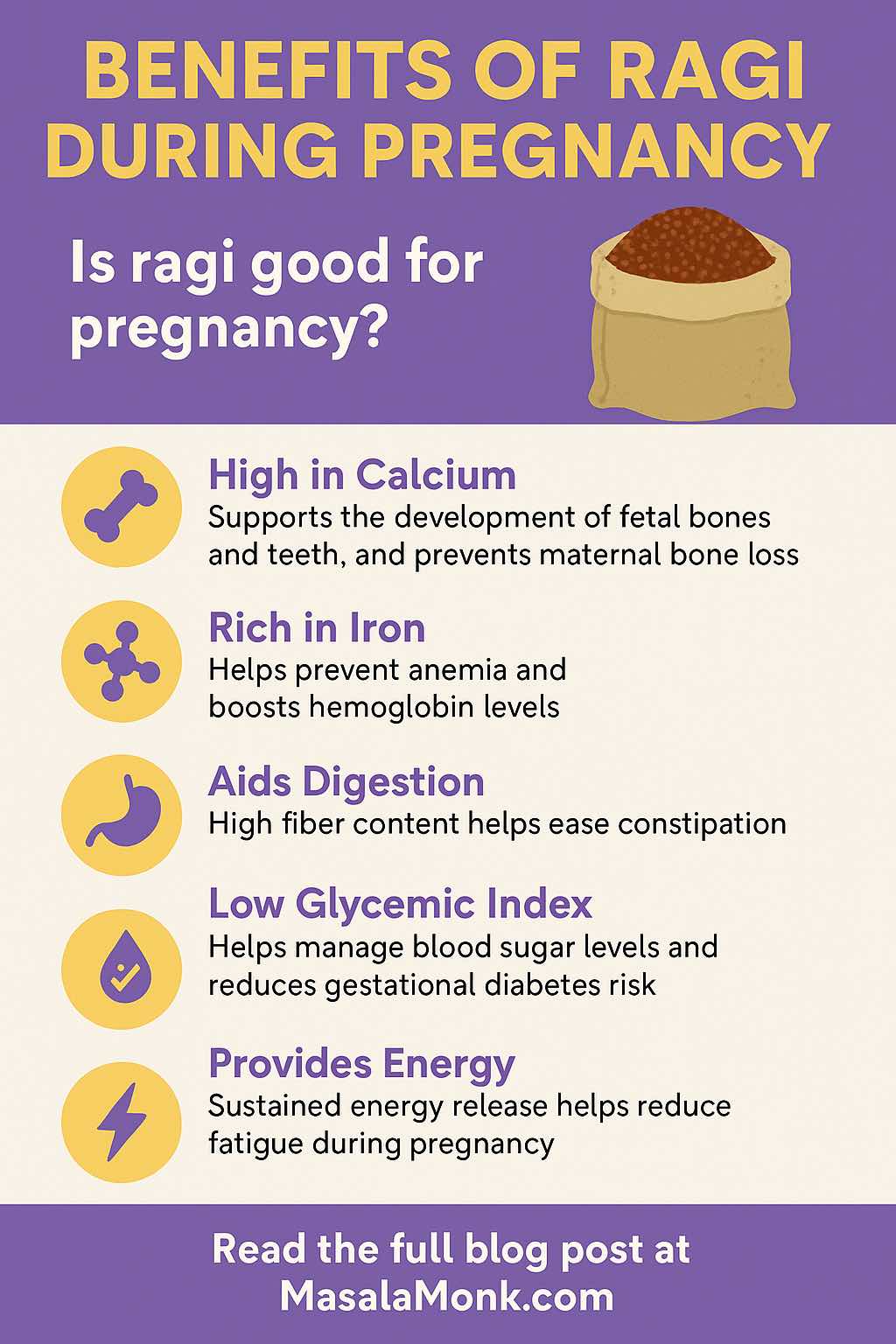
Pregnancy is one of the most exciting journeys of life — but it’s also one where every bite you take feels more important than ever. Friends, family, and even Google start throwing food advice at you:
“Eat more greens.”
“Cut down on sweets.”
“Have ragi, it’s so healthy for pregnant women!”
And if you’ve grown up in India, you’ve probably heard from your grandmother that ragi (finger millet) is a pregnancy superfood. But what’s the truth? Is ragi really good for you during pregnancy, and if yes, how much and in what form?
In this deep dive, we’ll explore:
- What makes ragi so special
- Nutrients that benefit both mother and baby
- When and how to eat it safely
- Possible side effects you should know about
- Delicious, practical ways to include it in your diet
By the end, you’ll be able to confidently decide how to make ragi a wholesome part of your pregnancy meals.
Also Read: Introduction to Pregnancy Nutrition: Empowering Your Journey to Motherhood
What is Ragi?
Ragi, or finger millet, is a tiny brown grain that has been part of traditional Indian diets for centuries. It’s especially popular in southern states like Karnataka and Tamil Nadu, but also enjoyed in parts of Maharashtra, Andhra Pradesh, and Odisha.
Traditionally, ragi has been known as a strength-giving grain. Farmers would eat ragi mudde (soft ragi balls) before a day of hard labor. Mothers would make ragi porridge for their children as a weaning food. And yes, expectant mothers were often advised to include ragi for its nourishing properties.
Unlike refined grains, ragi is whole and unpolished, which means it retains its bran, germ, and endosperm — and with that, its nutritional richness.
Nutritional Goldmine: Why Ragi is Loved in Pregnancy
Per 100 g, ragi provides:
- Calcium – ~344 mg (one of the richest plant-based sources)
- Iron – ~3.9 mg
- Protein – ~7 g
- Dietary Fiber – 3–3.6 g
- Phosphorus, Magnesium, Potassium – vital for cellular and muscular function
- Folate – supports early fetal neural development
- Essential amino acids like methionine and lysine
- Low Glycemic Index – ~50–55, supporting blood sugar stability
It’s naturally gluten-free and easy to digest when prepared correctly.
Benefits of Ragi During Pregnancy
1. Builds Strong Bones – For Mom & Baby 🦴
Calcium needs are higher during pregnancy, especially in the second and third trimesters when your baby’s bones and teeth are forming. Ragi’s exceptional calcium content supports:
- Fetal bone development
- Preventing maternal bone loss
- Reducing risk of osteoporosis later in life
💡 Many women who don’t drink milk find ragi a great alternative for calcium. Read about Building Blocks for Baby: 5 Calcium and Vitamin D-Rich Recipes for Expecting Mothers
2. Prevents Iron-Deficiency Anemia ❤️
Pregnancy increases your blood volume by almost 50%, which means your body needs more iron to produce hemoglobin. Low iron can lead to fatigue, dizziness, and developmental risks for the baby.
Ragi’s plant-based iron content, especially when paired with vitamin C-rich foods (like lemon or orange), can help:
- Maintain healthy hemoglobin levels
- Reduce tiredness
- Support oxygen supply to the fetus
Read: Anemia in Pregnancy: Impact and Solutions
3. Eases Constipation & Improves Digestion 🌿
Hormonal changes during pregnancy often slow digestion, leading to constipation. Ragi’s dietary fiber:
- Keeps bowel movements regular
- Supports gut health
- Prevents excessive weight gain
Tip: Fermented ragi dishes (like ragi idlis or dosas) are even gentler on digestion. Read about Fermented RAGI (Finger Millet) IDLIS- Gluten Free | Gut Friendly | Breakfast Recipe
4. Supports Healthy Weight Gain ⚖️
Ragi’s complex carbs release energy slowly, avoiding sugar spikes. This:
- Keeps you feeling full longer
- Prevents excessive snacking on unhealthy foods
- Supports steady weight gain, not sudden jumps
5. Helps Manage Gestational Diabetes Risk 🍚
Because ragi has a low glycemic index, it causes a gradual rise in blood sugar levels — making it suitable for pregnant women at risk of or managing gestational diabetes.
For more on pregnancy-friendly millets and blood sugar, read our guide to millets in pregnancy.
6. Boosts Energy Naturally ⚡
Ragi is rich in B vitamins and complex carbs, making it an excellent source of sustained energy. This is particularly helpful during the third trimester, when tiredness often peaks.
7. Supports Fetal Brain Development 🧠
Ragi contains folate and essential amino acids, both important for fetal neural tube development and brain growth — especially in the first trimester.
8. Naturally Gluten-Free 🌾
For expecting mothers with gluten intolerance or celiac disease, ragi is a safe, wholesome grain alternative.
How to Eat Ragi Safely in Pregnancy
Here’s how to make the most of ragi without overdoing it:
First Trimester
- Best form: Light ragi malt or thin porridge
- Keeps nausea in check and provides gentle nutrition
Second Trimester
- Best form: Ragi roti, dosa, or steamed idlis
- Higher calcium and iron needs — pair ragi with pulses for complete protein
Third Trimester
- Best form: Energy-boosting ragi laddoos or cutlets
- Helps with steady energy, fights constipation
6 Pregnancy-Friendly Ragi Recipes
- Ragi Porridge (Kanji) – Perfect breakfast for all trimesters
- Ragi Roti – Mix with wheat or jowar flour for better texture
- Ragi Dosa/Idli – Fermented, gut-friendly, and easy to digest
- Ragi Laddoos – Snack on them between meals
- Ragi Pancakes – Sweet or savory versions for variety
- Ragi Cutlets – Savory evening snack
👉 Get our millet cutlet recipe here and Fermented RAGI (Finger Millet) IDLIS- Gluten Free | Gut Friendly | Breakfast Recipe here.
Possible Side Effects of Ragi During Pregnancy
While ragi is safe for most women, be mindful of:
- Overeating → Can cause bloating or gas
- History of kidney stones → Limit intake due to oxalates
- Sudden introduction → Start with small portions to see how your body reacts
Common Myths About Ragi in Pregnancy
- “It makes the baby’s skin dark.”
Completely false — skin color is determined by genetics. - “It’s too heavy for pregnancy.”
Ragi is easy to digest when soaked, sprouted, or fermented.
Pairing Ragi with Other Pregnancy Superfoods
- Dates – For extra iron and energy 👉 Dates During Pregnancy
- Almonds – For healthy fats & protein 👉 7 Benefits of Almonds During Pregnancy
- Jaggery – Natural sweetener that boosts iron
Key Takeaways
- Ragi is safe and nutritious in pregnancy when eaten in moderation.
- Best known for its calcium, iron, and fiber content.
- Versatile grain — porridge, rotis, laddoos, dosas, pancakes.
- Ideal for bone health, digestion, steady energy, and blood sugar control.
You might also enjoy:
- 5 Protein-Packed Smoothies for Pregnancy with Peanut Butter and Chia Seeds
- Folate-Fortified Drinks for Pregnancy: 5 Non-Alcoholic Mocktails
- 5 Iron-Rich Snack Ideas for Pregnant Women: Energizing Chicken and Quinoa Combos
FAQs – Ragi During Pregnancy
1. Is ragi good for pregnancy?
Yes, ragi (finger millet) is considered very good during pregnancy. It’s rich in calcium, iron, folate, and fiber — nutrients that support fetal growth, bone development, and help prevent anemia. When eaten in moderation and prepared well, it’s safe and beneficial for expecting mothers.
2. Can we eat ragi during pregnancy every day?
Most women can eat ragi daily in moderate amounts — about 1–2 servings. It can be consumed as porridge, roti, dosa, laddoos, or idli. However, if you have kidney stone issues or are prone to bloating, you may want to limit it and consult your doctor.
3. What are the benefits of ragi during pregnancy?
Ragi provides:
- High calcium for strong bones and teeth (for mom & baby)
- Iron to prevent anemia
- Fiber for digestion and preventing constipation
- Low glycemic index to manage blood sugar
- Essential amino acids and folate for fetal brain development
4. Are there side effects of eating ragi during pregnancy?
While generally safe, eating too much ragi can cause gas, bloating, or constipation in some women. Its oxalate content may also increase the risk of kidney stones in susceptible people. Introduce it gradually and watch how your body responds.
5. Is ragi good for early pregnancy?
Yes, in the first trimester, ragi provides folate, iron, and calcium — all crucial for the baby’s early development. Start with light, easy-to-digest dishes like thin ragi porridge or malt to avoid nausea.
6. Can ragi be eaten during pregnancy in the third trimester?
Absolutely. In the third trimester, ragi helps with calcium needs, steady energy, and preventing constipation. Ragi laddoos, rotis, or fermented dosa/idli are excellent choices at this stage.
7. How to eat ragi during pregnancy for maximum benefits?
Soak, sprout, or ferment ragi before cooking to improve nutrient absorption. Pair it with vitamin C-rich foods like lemon or oranges to boost iron absorption. Popular options include ragi porridge, roti, dosa, pancakes, and laddoos.
8. Is ragi malt good during pregnancy?
Yes, ragi malt is an easy, nutritious drink during pregnancy. It’s filling, calcium-rich, and gentle on the stomach. Use jaggery instead of refined sugar to make it healthier.
9. Can pregnant women eat ragi flour?
Yes, ragi flour is safe. You can mix it with wheat flour to make rotis, use it for dosas, or add it to pancake batter. Mixing with other flours improves texture and taste.
10. Does eating ragi during pregnancy make the baby’s skin dark?
No, this is a myth. Skin color is determined by genetics, not by eating ragi or any other food. Ragi’s benefits are nutritional — supporting your baby’s growth, not changing appearance.












